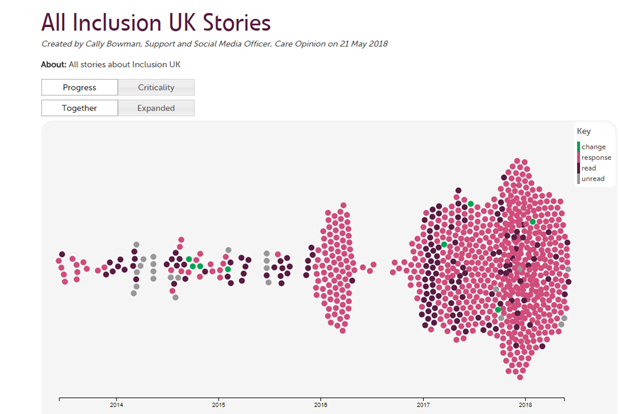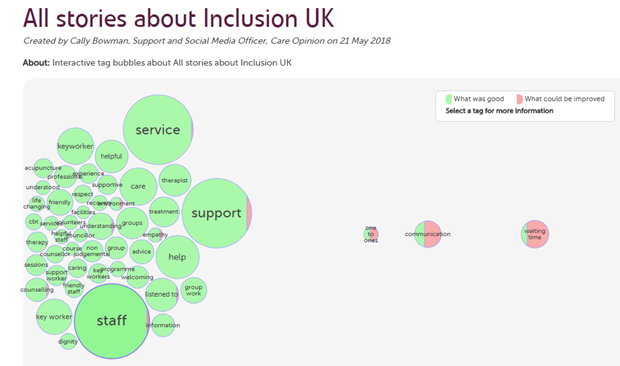
Care Opinion has been working with Inclusion now for nearly three years, providing the organisation with a safe and simple online platform to help service users give feedback to engage with and shape the services they access.
We caught up with Danny Hames, Inclusion's Head of Development, to discuss how this work has developed across Inclusion UK services.
What are the benefits for Inclusion of using Care Opinion?
First and foremost, I think that using Care Opinion is a statement that we make as an organisation. It shows that our service is transparent and accountable. This is a forum where we put ourselves up there for critique. It’s very important for a group of people who are so marginalised to have a voice about their care, a voice that is listened to and welcomed.
It provides an opportunity to tell us about what works well so we can reflect and see if we can replicate the positives in other areas. We can also review where we need to improve things. Sometimes we acknowledge feedback but can’t do anything at that time, and will explain why we cannot - the fundamental thing is listening to and respecting people’s views. It’s about engaging our service users and giving them the opportunity to feedback.
It’s also about realising that the demographic within substance misuse services is broadening and changing. We need to think about how we engage with people downstream and intervene early e.g. issues around alcohol abuse are still emerging and Care Opinion gives us an ability to let everyone engage.
What does the feedback tell you?
The stories we receive make recovery visible in a really positive way. Stories are there in public, google the service and the Care Opinion feedback comes up. It’s important and encouraging for someone who’s nervous about accessing a service, not knowing if it is going to do anything for them. It helps people know “I’m not the only one”. It helps across our services - mental health and also with our substance misuse services where this visibility is vital.
There are some key themes that emerge in stories. For example, people who have been hesitant about counselling and group work are surprised by how effective this has been. Lovely stories of people who were at a really low point, engaged with services and moved on. This recovery process is made visible on the site. There are several stories where individuals explain that they relapsed but “the service was still there for me” is really meaningful too.
What is the impact on services and managers?
Service managers are generally the ones responding to the stories. Inevitably, they don’t have as much front line service user contact as they would like, so it’s really positive that they have the opportunity to listen and respond in this way, which has a soft but important qualitative edge to it.
We all know what it’s like when you are running around and managing something, and people can become numbers not people. So, it is really valuable and powerful to reconnect the managers with the service users. It puts you back in touch with the experiences people are having at the front end of the service. That’s also why we value Care Opinion, it benefits service users but also staff massively. Here’s an example of a great response from a service manager to feedback.
How have you succeeded rolling out Care Opinion across dispersed services?
Understandably, some key workers were initially worried about the potential of exposing what they might see as their failings. Because of this it’s important to take time to explain the format of it, i.e. Care Opinion is transparent, but this is a professional system managed professionally and moderated accordingly. This isn’t just a free for all, there are structures and systems designed to protect people - but without compromising the value of the feedback.
We expect a lot from our clients in terms of change, honesty and transparency, so we should show the same to them. The safety of the system, how it is run and why we are doing it: once we get over those hurdles; that’s when staff get on board with it and understand why we are doing it.
Keeping the senior leadership team on board and understanding the value and how it works is important. We have now achieved effective working together through the senior team supporting local managers whilst also setting clear expectations. The key change maker really is the service manager, it’s about getting them on board.
Dependent on the size of the service, you need a number of change makers who can influence and champion feedback. It’s essential to have the service manager on board but really you need other people as well. So, there’s an element of being realistic about how long it takes to embed and change.
What have been the practical steps you have taken?
Regular conference calls with all the service managers have really helped a joined-up approach. Teleconferences work because it helps people connect and facilitate shared learning and a ‘pulling each other along’ element. The scheduled reports and visualisations from the site help both national and local monitoring of the feedback. The summary report which we now have from Care Opinion, is presented at the monthly senior management team meetings. In the Inclusion blog we have a Care Opinion story of a month.
It was so helpful that we had a forerunner service who showed the way for others. Inclusion Matters Wirral were brilliant and showed people what could be done, right from the offset.
On reflection, one of the things we were up against was this idea that it only works in particular services, a kind of parochialism, whereas we have shown it can work across the board. But different services need to find ways that suit their users and how they deliver their care. Ultimately people are people, who if given the opportunity to comment on their care should be able to do so.
Here for example is a story swarm for the postings for Inclusion that shows the spread of stories and progress over the years.
What is the value to your organisation externally e.g. stakeholders and commissioners?
Working with Care Opinion pretty much sets us aside from other organisations because I don’t know any other large voluntary sector providers that put themselves up to that scrutiny.
Regular conversations with commissioners now include a report from Care Opinion. The structure and variety of reporting that you can do is so helpful, especially the tag bubble visualisation reporting option (see below). Service managers can use it every few weeks, perhaps highlighting a particular story, “we got this story did you see it?” Both as an example of good practice but also how we have responded to negative comments and suggestions.
With tender submissions, it forms a very central plank of how we enable service users to participate in the development of our services.
It’s accessible. It’s modern. It’s digital.
Can Care Opinion work in a Substance Misuse & Mental Health Service?
Can Care Opinion work in a Substance Misuse & Mental Health Service? https://www.careopinion.org.uk/resources/blog-resources/1-images/5510589162714718b315ccbb28a6a8d2.png Care Opinion 0114 281 6256 https://www.careopinion.org.uk /content/uk/logos/co-header-logo-2020-default.pngQuestion from Care Opinion
Posted by Cally Bowman, Engagement & Support Officer, Subscriber Support, Care Opinion, on
About: Inclusion
Thanks for your feedback.


